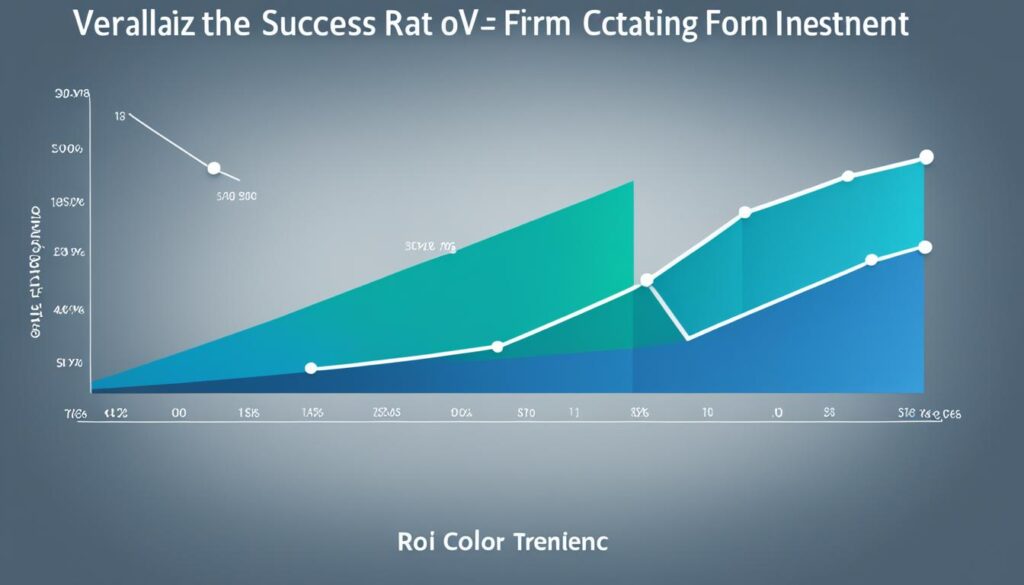The venture capital industry has long been shrouded in a veil of mythical success stories, with tales of daring entrepreneurs and their trail-blazing investors. However, the reality of the VC world may surprise you. Today, venture capitalists are more akin to conservative bankers than the risk-takers of yesteryear, carving out a specialized niche within the capital markets to meet the needs of institutional investors, entrepreneurs, and investment bankers alike.
As the landscape of the venture capital industry has shifted, so too have the metrics used to measure the success of VC firms. No longer is it enough to simply point to a handful of blockbuster investments – the true test of a firm’s prowess lies in its ability to deliver consistently superior returns on inherently risky bets. So, what is the success rate of a VC firm, and how can it be quantified? Delve into the data and uncover the realities behind the myths that have long surrounded this dynamic industry.
Key Takeaways
- The venture capital industry has evolved from its risk-taking roots to a more conservative, banker-like role.
- Measuring the success of a VC firm involves complex metrics like internal rate of return (IRR) and the ratio of exits to investments.
- The overall odds of a startup receiving funding from a top VC firm and then succeeding are extremely low, around 0.05% or 1 in 2,000.
- VCs look for startups with a huge market, differentiating technology, and incredible people, with a particular focus on founder qualities like courage and genius.
- Effective pitching to VCs is critical, as good pitches can walk through the “idea maze” while bad pitches lack cohesion and realism.
Understanding the Venture Capital Industry
The venture capital industry has evolved significantly from its earlier days, with venture capitalists now playing a more conservative, banker-like role rather than the risk-takers of the past. Today, venture capitalists are strategic players in the capital markets, filling a crucial void that other institutions cannot serve. They are the linchpins in an efficient system that meets the needs of institutional investors seeking high returns, entrepreneurs seeking funding, and investment bankers looking for companies to sell.
Separating Myths from Realities
The popular mythology surrounding the venture capital industry often paints a picture of venture capitalists investing in good ideas and good plans. However, the reality is that they focus on investing in industries that are more competitively forgiving than the market as a whole. Venture capitalists structure their deals in a way that minimizes their risk and maximizes their returns, rather than simply backing the most promising startup concepts.
The Role of Venture Capitalists
Venture capitalists play a vital role in the entrepreneurial ecosystem, providing startups with the funding and guidance needed to scale their businesses. They must earn a consistently superior return on their investments in inherently risky ventures. This requires a keen understanding of the industries they target and a strategic approach to deal structuring that allows them to mitigate their risks while maximizing their potential returns.

Measuring Success in the VC World
Evaluating the success of a venture capital (VC) firm is not a straightforward task, as it involves a complex set of metrics and considerations. Two key performance indicators that are widely used in the VC industry are the internal rate of return (IRR) and the ratio of exits to investments.
Internal Rate of Return (IRR)
The internal rate of return (IRR) is a widely recognized metric for measuring the profitability of VC investments. It represents the annualized rate of return that a VC firm generates on its portfolio companies. A high IRR is a strong indicator of a VC firm’s ability to consistently generate above-market returns for its investors, which is the primary goal of any successful VC operation.
Ratio of Exits to Investments
Another important measure of a VC firm’s performance is the ratio of exits to investments. This metric tracks the percentage of a firm’s investments that have resulted in successful startup exits, such as acquisitions or initial public offerings (IPOs). A high ratio of exits to investments suggests that the VC firm has been effective in identifying and supporting promising startups that can achieve significant growth and liquidity events.
| Metric | Description | Importance |
|---|---|---|
| Internal Rate of Return (IRR) | The annualized rate of return generated on VC investments | Indicates a VC firm’s ability to consistently generate above-market returns for investors |
| Ratio of Exits to Investments | The percentage of a VC firm’s investments that have resulted in successful startup exits | Reflects the firm’s effectiveness in identifying and supporting promising startups with the potential for significant growth and liquidity events |
By closely monitoring these VC firm success metrics, investors can gain valuable insights into the performance and investment strategies of different VC firms, enabling them to make more informed decisions when allocating capital to the venture capital industry.

What is the success rate of a VC firm?
When it comes to the venture capital industry, the odds of a startup receiving funding from a top VC firm can be quite daunting. According to Marc Andreessen, founding partner of Andreessen Horowitz, the odds of being funded by his firm are approximately 0.7%. Andreessen recently provided an interesting breakdown of these odds in an interview at Stanford Graduate Business School.
Andreessen explained that out of the 4,000 startups looking for funding, his firm reviews about 3,000 per year. However, they ultimately invest in only around 20 startups annually, which translates to a 0.7% funding rate. This statistic highlights the highly competitive nature of the startup funding odds and the success rate of top VC firms.
The Odds of Succeeding for a Startup Funded by a Top VC
Even for startups fortunate enough to secure funding from a premier VC firm like Andreessen Horowitz, the odds of long-term success remain challenging. Industry data suggests that the total odds of success for a VC-backed startup are approximately 0.05% or 1 in 2,000.
This statistic underscores the immense hurdles faced by entrepreneurs seeking startup funding and the success rate of VC-backed companies. Navigating the venture capital landscape requires not only a groundbreaking idea and strong execution but also a healthy dose of luck and timing.

The Total Odds of Success
Combining the startup funding odds and the success rate of VC-backed startups, the overall success rate of a VC firm appears to be exceptionally low. With the odds of being funded by a top VC firm at just 0.7% and the total odds of success for a VC-backed startup at a mere 0.05%, the total odds of success for an entrepreneur seeking venture capital funding can be daunting.
These figures highlight the challenges facing both startups and VC firms in the current investment landscape. As the venture capital industry continues to evolve, understanding the nuances of VC firm success rates and startup funding odds will be crucial for entrepreneurs and investors alike.
What Do VCs Look for in a Startup?
When a sponsor like Andreessen Horowitz considers funding a startup, they focus on a few key attributes. The three primary qualities they seek in a startup are a huge market, differentiating technology, and incredible people. These criteria are quite logical – if the market size is too small, it doesn’t matter how great the product or service is, as the potential impact will be limited. Similarly, if the technology is too similar to competitors, the odds of breaking away from the pack are low. Ultimately, without incredible people leading the charge, neither of the other two criteria holds much weight.
Huge Market
Venture capitalists are looking for startups that have the potential to capture a significant share of a large, growing market. The size of the addressable market is a critical factor, as it directly correlates with the potential upside for the investment. A startup with a huge market opportunity has a far better chance of delivering the outsized returns that VCs require to justify the inherent risks of early-stage investing.
Differentiating Technology
In addition to a huge market, venture capitalists also place a premium on differentiating technology that sets a startup apart from the competition. This could be a novel product, a unique approach to solving a problem, or a transformative innovation that disrupts an established industry. Startups that can demonstrate a clear technological advantage are more likely to capture significant market share and achieve sustainable growth.
Incredible People
Perhaps the most important criterion for venture capitalists is the quality of the startup’s team and leadership. VCs are not just investing in a product or service, but in the people who will execute the vision and navigate the inevitable challenges of building a successful business. They look for founders and key team members with a track record of success, a deep understanding of the market, and the tenacity to overcome obstacles and drive the company forward.

Qualities VCs Seek in Founders
When it comes to investing in startups, venture capital (VC) firms often place a significant emphasis on the qualities and characteristics of the founding team. According to industry experts, the VC founder criteria boil down to two primary traits: courage and genius.
Courage
VCs are drawn to founders who possess unwavering startup founder qualities like courage. This means not giving up in the face of adversity, remaining determined to succeed, and demonstrating the ability to learn from mistakes. Founders who exhibit this level of founder courage are often better equipped to navigate the many challenges that come with building a successful venture.
Genius
In addition to courage, VCs also seek out founders with a unique and exceptional level of founder genius. This encompasses their ideas, problem-solving abilities, and overall way of thinking. Unlike courage, which can be developed through conditioning and experience, founder genius is often considered more intrinsic and harder to cultivate.
By prioritizing these two key traits – courage and genius – VC firms aim to identify founders who have the best chance of turning their ambitious visions into successful, high-growth startups.

Pitching to VCs
When it comes to securing funding from venture capitalists (VCs), the art of the pitch is paramount. According to Marc Andreessen, a founding partner at Andreessen Horowitz, a successful
startup pitch to VCs
can effectively guide investors through the “idea maze” – demonstrating how the original concept has evolved into a viable, commercial solution.
Good Pitches
A good VC pitch is concise, logical, and compelling. It must convey the startup’s journey from initial idea to a product or service that can thrive in the marketplace. With limited time to present to an investment committee, the pitch narrative must be tightly structured, clearly explaining the problem, the solution, the target market, and the team’s ability to execute.
Bad Pitches
In contrast, a bad VC pitch lacks the essential qualities of a successful pitch. Common pitfalls include:
- Failing to clearly articulate the “idea maze” and how the concept has been refined
- Targeting a small, unattractive market
- Proposing an ordinary technology or product with no clear differentiation
- Presenting a team without the necessary skills and experience
- Founder’s inability to defend their position when challenged
- Pitching a “me-too” strategy that closely mimics existing solutions (e.g., “It’s like Snapchat, but for cats”)
Delivering a compelling, well-structured VC pitch is crucial for startups seeking to capture the attention of seasoned investors. By avoiding the common mistakes and focusing on the key elements of a successful pitch, entrepreneurs can increase their chances of securing the venture capital needed to scale their business.

Resources for Startups and Founders
If you’re hoping to raise money from a top venture capital firm, then you’ve definitely got your work cut out for you! To help you prepare for your VC pitch, we’ve got plenty of startup resources and founder resources to support you.
One key resource is the Corporate Finance Institute’s guide on how VCs evaluate startups and founders. This comprehensive guide delves into the criteria VCs use when assessing VC pitch preparation and VC fundraising support, including market size, technology differentiation, and the qualities they look for in founders.
Another valuable resource is the Andreessen Horowitz blog, which provides insights straight from one of the top VC firms on what they look for in startups and founders. This can be immensely helpful as you craft your VC pitch and prepare for the high-stakes fundraising process.
Remember, the odds of receiving funding from a top VC firm like Andreessen Horowitz are slim, around 0.7%. But with the right startup resources and founder resources in your arsenal, you can put your best foot forward and maximize your chances of securing that all-important VC investment.
Why Most Venture-Backed Companies Fail
Despite the glamorous stories of VC-backed startup success, the harsh reality is that the majority of venture-backed companies fail to achieve their desired goals. According to research from Harvard Business School, only a small percentage of VC-backed startups actually succeed, while the success rate of venture capital firms remains relatively low compared to the total number of investments made.
Studies have shown that most venture-backed companies fail to meet expectations and ultimately do not survive in the market. The success rate of VC firms can vary depending on the industry sectors they invest in, with some sectors experiencing higher success rates than others. However, the overall data indicates that a significant portion of VC-backed companies struggle to sustain growth and profitability over the long term.
Factors such as market conditions, competition, and internal management play crucial roles in determining the success rate of VC-backed companies. Venture capital firms often face challenges in identifying and nurturing successful businesses due to the high failure rate among their portfolio companies, which poses significant challenges for the venture capital industry.

The reasons for startup failure and the challenges facing the venture capital industry are complex and multi-faceted. Understanding these factors is essential for entrepreneurs and investors alike, as they navigate the VC-backed startup ecosystem and strive to overcome the odds of success.
The Role of Timing and Luck
In the captivating world of entrepreneurship and venture capital, the role of startup timing and luck cannot be overstated. While the popular imagination is often enamored with the heroic tales of Silicon Valley’s risk-taking cowboys, the reality is that factors in startup success often hinge on more than just brilliant ideas and relentless determination.
As the statistics reveal, serial entrepreneurs who have previously succeeded in a venture have a 30% chance of replicating that success, compared to just 18% for first-time entrepreneurs and 20% for those who have failed before. This suggests that timing and luck play a significant role in venture capital investments, with more experienced firms more likely to back startups that ultimately succeed.
Moreover, the data indicates that top-tier venture capital firms tend to invest at higher valuations, reflecting their confidence in the higher success rates of the startups they fund. This, in turn, translates to higher average investment multiples for companies led by previously successful serial entrepreneurs.
Intriguingly, the venture capital market appears to exhibit imperfect competition, as the excess returns generated by investing in serial entrepreneurs have not been entirely eliminated through increased competition and bidding. This suggests that timing and luck continue to hold sway in this dynamic ecosystem, where the path to success is not always paved with meritocracy alone.

Conclusion
The venture capital industry has undoubtedly evolved over the years, with venture capitalists now taking on a more conservative, banker-like role. Measuring the success of a VC firm is a complex endeavor, relying on key metrics such as internal rate of return (IRR) and the ratio of exits to investments. However, the overall odds of a startup receiving funding from a top VC firm and then succeeding are staggeringly low, estimated at around 0.05% or 1 in 2,000.
Venture capitalists are highly selective, seeking startups with a huge market, differentiating technology, and incredible people, with a particular emphasis on founder qualities like courage and genius. Effective pitching to VCs is critical, as the best pitches can guide investors through the “idea maze,” while poor pitches often lack coherence and realism.
While the venture capital ecosystem remains a vital driver of innovation and entrepreneurship in the United States, the challenges facing both startups and VC firms are significant. The startup funding challenges and the VC firm success rates underscore the complexities inherent in this dynamic industry. As the landscape continues to evolve, adaptability and a keen understanding of the critical success factors will be key for all players seeking to thrive in the competitive world of venture capital.
